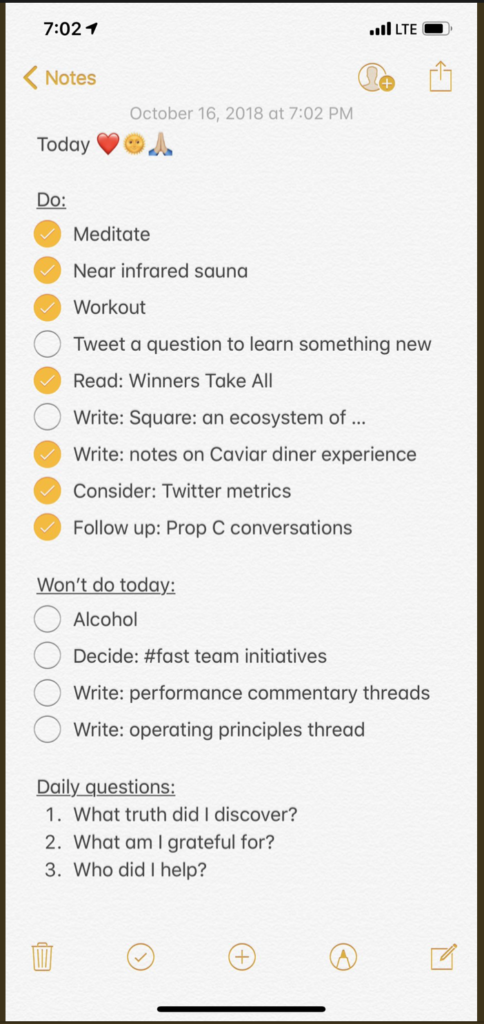The single most valuable thing you can do for your business is to become a master at prioritization, a skill that ensures your organization meets its short and long-term goals.
Barbara Corcoran, founder of The Corcoran Group and star of Shark Tank, takes prioritization so seriously that she grades every task she needs to accomplish each day. Each task is assigned an A, B, or C and is completed in that order.
Jack Dorsey, founder of Twitter, starts his day by writing down everything he will prioritize that day and every task he refuses to be distracted by. Here’s what his daily to do list looks like:

These successful founders have discovered the secret to effectiveness in prioritization. With a net worth of $80 million, Barbara has become an expert at prioritizing the tasks that move the needle for her various business endeavors, ensuring she continues to lead her businesses with the most impact possible. Jack Dorsey, worth $5 billion, says no to any task that doesn’t help Twitter keep its 68 million users happy.
These business leaders have mastered prioritization and have used this expertise to amass their fortunes. Yet, just like their businesses, there is no such thing as a one size fits all prioritization system.
Here is how Brian Chesky, founder of Airbnb, Whitney Wolfe, founder of Bumble and Michael Phelps, most decorated Olympian in history, and Richard Branson, founder of Virgin Atlantic, prioritize their tasks to catalyze their personal and career success.
Prioritization of Daily Tasks
Brian Chesky, founder of Airbnb, starts his day by creating a daily task list, similar to Corcoran and Dorsey. With 33.9 million people using his platform, Brian has to focus on the tasks that will continue to keep his company as one of the most successful startups currently in operation.
When interviewed on the Masters of Scale Podcast, Brian gave away his secret to prioritization. He explained to host Reid Hoffman (who is the co-founder of LinkedIn) that he prioritizes some tasks over the other by writing down a list of everything he needs to get done. Then, he’d look at the list and ask himself, what tasks can be accomplished and as a result, lead to the other tasks being completed as well?
For example, if he has a list of twenty tasks, he’ll find the three most important tasks that will catalyze the completion of the remaining seventeen tasks. Then, Brian does something surprising.
Unlike Corcoran who grades the rest of the task with a B or C, Chesky will completely remove the following tasks. In the example above, he’ll axe the seventeen remaining tasks. According to his interview, Chesky pulls a Jack Dorsey and avoids these tasks altogether. With a net worth of $3.7 billion, according to Forbes, the power of prioritization is in Chesky’s bank account.
Whitney Wolfe, founder of Bumble, the dating app that only allows women to message first, has a similar strategy to prioritize the most important tasks of her busy day. She uses the prioritization strategy of asking herself the ‘question of nine’ to determine if a task is important enough to put on her to do list.
For example, if an urgent task appears she’ll ask herself, “Will this matter in nine minutes?” If the answer is no, the task is axed. She continues asking herself this question through the rule of nine to categorize each task.
The escalation goes as so:
1. Will this matter in nine minutes?
2. Will this matter in nine hours?
3. Will this matter in nine days?
4. Will this matter in nine weeks?
5. Will this matter in nine months?
6. Will this matter in nine years?
This prioritization strategy gives Whitney the ability to pick and choose what she’s willing to spend time (her most valuable asset) completing. If it doesn’t matter in nine minutes, the task doesn’t make it to that day’s to-do list. If it will matter in nine years, the task becomes the number one priority of that day.
In a similar long-term approach, Michael Phelps reminds himself on a daily basis of his long-term goals so he can be sure his day to day actions are helping him achieve them.
Connecting Daily Tasks to Long-Term Goals
As the most decorated Olympian of all time, Phelps is no stranger to setting and achieving goals. In order to stay on track and meet his uses a similar prioritization strategy to make sure he’s on track to meet his five, ten and twenty year goals, Phelps wrote down his short term and long term goals and keeps them on his nightstand to remind him to stay focused, both on his personal wellbeing and professional career.
Phelps uses these written goals to remind him not to prioritize tasks that aren’t going to help him reach his goals. Richard Branson follows the same priority model. He keeps a notebook in his back pocket at all times to write down new goals and tasks as he thinks of them.
“Keep a notebook in your back pocket to scribble down thoughts or feedback, and make sure you follow through on them in a timely fashion.”
According to Branson, 99% of people in leadership roles don’t take notes. Branson credits Virgin Atlantic’s success to noticing the small details, writing them down and then taking action on them. These notes become his prioritization, the first thing that he knows needs to get done to ensure his customers remain happy and he’s able to achieve his annual goals.
Phelps and Branson have become experts at setting goals and reminding themselves of them later so they can actually be achieved.
In Gary Keller’s New York Times Best Selling Book, The ONE Thing: The Surprisingly Simple Truth Behind Extraordinary Results, he explains how the power of prioritization gifts leaders with the magic power of having more by doing less. This concept nominated The One Thing as one of the Top 100 Business Books of All Time from Goodreads and is how Keller has been able to amass a $200 million dollar net worth through his real estate company, Keller Williams.
An important idea highlighted in his book was having more by doing less. This concept can sound strange at first, we get it. Let’s explain.
Prioritization of Creative Time
How can you be more effective by doing less?
Just as Keller explains in his book, doing more isn’t successful prioritizing. Doing less and creating more is successful prioritizing.
Business leaders like Jeff Weiner, founder of LinkedIN, and Daniel Ek, founder of Spotify, have taken the idea of prioritization to this next level. Weiner and Ek both prioritize the most important tasks of the day and prioritize empty time slots that they refuse to fill with tasks.
Jeff Weiner. CEO of LinkedIn, follows a strict morning routine and then purposely prioritizes time slots for creativity, which he refers to as buffer time.
“The key to time management is carving out time to think, as opposed to constantly reacting. It’s just time to catch my breath. It’s made an enormous difference.”
This buffer time can last up to ninety-minutes and is prioritized for brainstorming, responding to emails and allocating time towards unplanned mentorship and meetings. Creating buffer time helped Jeff establish LinkedIN as a $26.2 billion dollar behemoth that got acquired by Microsoft in 2016. Spotify founder Daniel Ek uses the same strategy to prioritize free time to think, a routine that has made his company a leader in the music subscription space.
“People think that creativity is this free spirit that has no boundaries. No, actually the most creative people in the world schedule their creativity. That’s the irony. So I try to do the same. I just don’t have as many meetings as you think. Instead I have a lot of me time where I’m just thinking; I’m at a whiteboard drawing by myself. Occasionally I might have someone with me. If I have a call or another meeting, I’ll just block it out if I’m in the zone. That’s unorthodox because it means that you’re breaking social contracts, you’re disappointing someone because you didn’t show up. But if you’re really, really focused, those are the times when the breakthroughs come.”
These business leaders and athletic moguls have taught us three important lessons:
- Write down your daily task list and choose your prioritizing system
- Have your long-term goals on hand at all times to remember what you’re working towards
- Leave well-defined time slots for free thinking
To become a highly effective person like these business leaders, we can use their prioritization approach to create our own task system that works for our personal well being and company’s future, while supporting long-term goals and creative time.
Creating Your Own Prioritization System
Your Daily Task List
The first step is to create a space for your daily task list. Many people love the tactile feel of pen and paper. Others value the security and accessibility of using a digital platform. A major advantage of putting your task lists on a digital platform (besides the aforementioned accessibility and backup) is that it’s easier to share with others. If your task list needs to be delegated to other members of your team, placing this in your project management tool will create a seamless experience of prioritization and delegation in your entire team.
Brief offers this task list, allowing you to have a personal task list and easily sharing and delegating tasks to others if necessary. We also have chat, project tasks and file storage in one place, so you don’t have to lose too much time fiddling around dozens of different apps and accounts. Here is a complete list of productivity apps to choose from, including tools that will help automate tasks on your to-do list.
Now, decide how you will determine what tasks get completed and which don’t. Remember, this is not a one size fits all model. Chesky may be okay with axing 17 out of 20 tasks, but it may work better for another business owner to only remove 10 at a time.
If you’re not sure how to begin your prioritization system, test out the different methods above. For example, for one week use Jack Dorsey’s system of writing down what you will do and what under no circumstances you won’t do. The next week, pull a Chesky and axe 80% of your tasks). The following week, ask yourself if the task will matter in nine minutes, nine days, nine weeks, and so on.
Find the system that works best for you and your company. Remember: different systems may work better at different stages of your company’s growth.
Your Long-Term Goal List
As fans of having all of your tasks in one place, we suggest placing your long-term goals in the same digital space as your daily tasks. This way you’re prioritizing and delegating tasks and looking at the bigger picture. You can ask yourself questions like, “Does this task need to be completed today to help reach our 5-year goal?” or “Will deprioritizing this task catalyze me towards our annual goal?”.
Phelps and Branson use paper and pen to remind themselves of their goals. This is a great method but may slow down progress if your notebook isn’t with you at all time. With that said, there are lots of small notebook options that can fit into your back pocket or backpack easily.
Your Creative Time
The last step is to ensure you are doing more, by doing less. You don’t necessarily have to fall into the hustle porn mentality of working fifteen hour days. Instead, pull yourself back into reality and remember that your mind is what will move you from Point A to Point B and if you don’t give yourself time to brainstorm and work around problems, success will be hard.
Meditation, quiet time, writing time, or allocating time to input instead of only output is an integral part of success (especially if you want to keep your sanity throughout the journey). As Weiner and Ek show us, to be forward thinkers you have to have time to think.
The most valuable asset you can provide your business with is a healthy prioritization system that structures your daily tasks, long-term goals and creativite exploration in one place. This is the secret of business leaders and the most decorated athlete in history.
Join Brief for free to start prioritizing and move your team forward.




